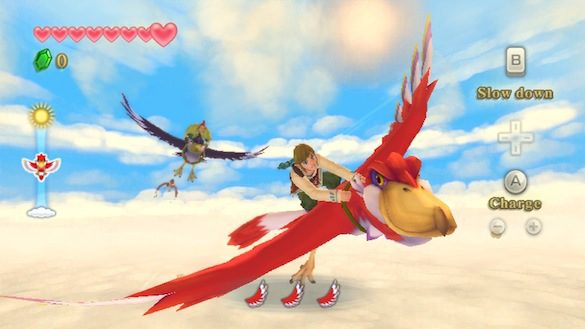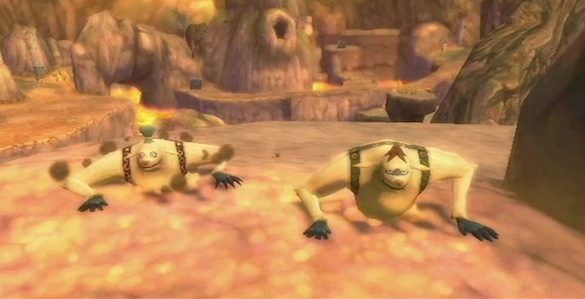This Thanksgiving, we have many things to be thankful for. Some are thankful for the blessings in their lives, while some are thankful for having such loving friends and family. I’m thankful to have a new Zelda game to play through, The Legend of Zelda: Skyward Sword, Link’s first true adventure for the Wii. The question is, however, does it soar above the clouds or does it plummet to the ground?
We’ve all grown to know and love these games. Ever since The Legend of Zelda was released for the NES back in 1986, Link has been in our hearts. A feature that brings us back each and every time is the fact that rarely are these games ever mediocre. Each and every game is like an intricate sculpture, with so much love and detail chiseled in until it’s perfect in the creator’s eyes. Fans have been eagerly awaiting a game to topple the magnum opus of the Zelda series, The Legend of Zelda: Ocarina of Time. This game comes quite close to doing so.
The game starts off rather slowly, showing off the gameplay and introducing you to the main denizens of Skyloft, yet it doesn’t feel like it’s too slow. The game utilizes Wii Motion Plus technology for most of the gameplay mechanics, which is the game’s shining crown, and also its biggest downfall. When it works, the controls are superb, besting any prior control scheme. After playing the game for a while, you will never want to go back to playing Zelda any other way. The sword perfectly mimics your wrist movements, leading to precise swordplay. The items work perfectly with the Motion Plus technology, allowing you to move and still be able to effectively use an item, a mechanic that I’ve always wanted implemented. Also, a new stamina system is introduced for running and climbing, which works better than I had expected. It seems balanced perfectly, and I never found myself annoyed when something called for running or climbing.

Fighting Technoblins requires precision
Then comes flying, which is the worst thing I’ve ever comes across in a Zelda game. For some strange reason, I could never get the Loftwing to move correctly, leading to an intense frustration unlike any that I have ever felt before. I would be flying towards a destination, experiencing no problems, when, all of a sudden, my Loftwing would start flapping its wings and then proceed to slowly descend. This would then happen without relent, constantly breaking the fourth wall. Flying in Skyward Sword became a Hell for me, especially when precision was required. The funny thing is that everyone else seems to have an exquisite experience when flying. I guess that I must live in an alternate universe where playing a Zelda game isn’t a wonderful experience.

The story itself takes a long time to unravel. It spends a lot of time in familiar territory that we’ve grown to expect in a Zelda game, but by the time you have completed that game, the story has become one that can stand up against some of the best in the series. The story ends up answering a lot of questions, and to be quite honest, the story pretty much blew my mind. It ties up a lot of loose ends found throughout the Zelda series, some of which I never thought of myself. Skyward Sword is a proper prequel to the entire series, foreshadowing just about everything that happens in the rest of the games. If you consider yourself a diehard Zelda fan, you need to pick up this game even if just for the story, although it isn’t the only superb thing about this game.
The characters feel even more realistic than I could have anticipated. Never before have the characters in a Zelda game breathed with so much life. The cutscenes are magnificent, bringing out the energy of all of the characters. All of the characters feel real, and their emotions bleed out in the cutscene sequences. Zelda is more of a side-character this time around and actually seems human; Link doesn’t appear as lifeless as usual. The two share a special bond that forms the basis of the plot, connecting them to several other characters through their friendship. Lord Ghirahim is the shining star in the cast, a fitting replacement for Ganon, a staple baddie for the series. My only complaint is that I didn’t see Ghirahim as much as I would have liked (not a legitimate complaint, obviously). New races are introduced in favor of older staples (except for the Gorons), and they are ones that I would like to see return again sometime (except for the water-dwelling Parella, who seem under-developed).
 The new Mogma race, a treasure-obsessed group
The new Mogma race, a treasure-obsessed group
The dungeons in The Legend of Zelda: Skyward Sword are among some of the best in the series, and I’m going to go as far as saying that the final dungeon is the best dungeon I have ever encountered in a Zelda game. All of them are smaller than the dungeons found in other entries in the series, but that doesn’t mean that they won’t take as long to complete. Each room in each dungeon is chocked full of clever puzzles, which are as head-scratchingly difficult as any seen before. I got stuck quite frequently, just about as often as I have before when playing a Zelda game. Thankfully, there are zero torch puzzles in this game. Yes, I’m serious. All of the puzzle are fresh and provide a nice experience. And puzzles aren’t just confined to dungeons. The overworld is a dungeon too, in all honesty. The main dungeons are actually sort of like dungeons within dungeons (crazy, eh?). The boss fights were also extremely pleasing. None of the boss fights were incredibly easy, and they were all memorable. There were no “look at my giant glowing weak spot” fights (except for one, perhaps). I will complain about one boss fight, though. I had to face the same monster three times over the course of the game, and each time it was just about the same fight in the same area. They could have thrown in a little bit more to spice up the fights besides “Oh, I have an extra appendage this time.”
The graphics for Skyward Sword may not be the greatest ever (even for a Wii game), but trust me, that’s not an issue. The graphical style goes for a medium between The Legend of Zelda: Wind Waker’s cartoonish expressionism and The Legend of Zelda: Twilight Princess’ stark realism, but does it work for this game? Yes, it most certainly works. The graphical style seems to be the perfect artistic style for a Legend of Zelda game. It just seems like the perfect compliment for the game. I especially love how the environment turns into a blotchy watercolor painting when viewed in the far off distance. It’s lovely and it just works; that’s that.
This game is also quite lengthy, pulling in around 40 hours just focusing on the main storyline. Sometimes, though, it feels like it’s little too much, with random quests thrown in for filler. Most of it was enjoyable, however, especially a section later in the game where you go swimming in order to try and catch a bunch of swimming musical notes. One section, though, requires you to go through a dungeon again, which I found to be quite purposeless and annoying. They could have added a new area to explore for that mission instead of rehashing the same area that you have already gone through. The side quests are fun and can add on a lot to the lengthy quest if you’re not satisfied. Also, after completing the game, you can start a second quest called “Hero Mode,” which will provide a challenge for all of those seeking one. You can also find treasure located throughout the world to use for upgrading your gear and potions, which also adds a nice diversion for all of those who need it. You can spend countless hours trying to complete each quest, finding every last Piece of Heart and Goddess Stone (and its respective treasure), and upgrading all of your gear.

The menus are also very nice, and navigating is a breeze; just flick your wrist to switch between collectables and gear. You also have the ability to hide part of your HUD, which is nice for those of you who don’t want to have to stare at a giant Wii remote throughout the game. Also, you can place “beacons” on your map, which can become very helpful when flying to a location.
Fi is not only a main character in the game but is also an integral part of the gameplay. You can call upon her when you need advice about the environment or an enemy, although I don’t know why I need to be told what my battle performance is every time I inquire about an enemy. I’m going to remember which enemies are a pain to fight and which ones are not. Also, I don’t need Fi to alert me when I’m low on hearts; I can clearly tell. But these are minor gripes; at least I don’t have anyone yelling “HEY! HI! LOOK OUT! LISTEN” every five seconds (just kidding).
The music is great, although there are not many pieces that remain memorable. Actually, there are only a handful that I can remember at the moment. Skyward Sword boasts a completely orchestrated soundtrack, which is wonderful, but, when I come to think of classic Zelda arrangments, I doubt many (if any at all) will come to mind.
So here we are, at the conclusion of the review. It was a great flight at times, although sometimes it got a little bumpy when the controls didn’t work or when it seemed like things were just added in as fat to lengthen the game. When the controls work, they work superbly, and the dungeons and boss fights were unforgettable. The story left me speechless by the end, and it proves that there is some sort of master storyline hidden away at Nintendo. For The Legend of Zelda, the sky’s the limit.
Review
| Pros | Cons |
|---|---|
| Great story Controls work superbly Perfect graphical style Lengthy game with plenty of extras Brilliant boss and dungeon design Overworld is given more depth Customizable HUD More believable characters and lively cutscenes | Controls for flying rarely work Some parts of the game seem like useless filler material Story is slow to start |
| Rating |


